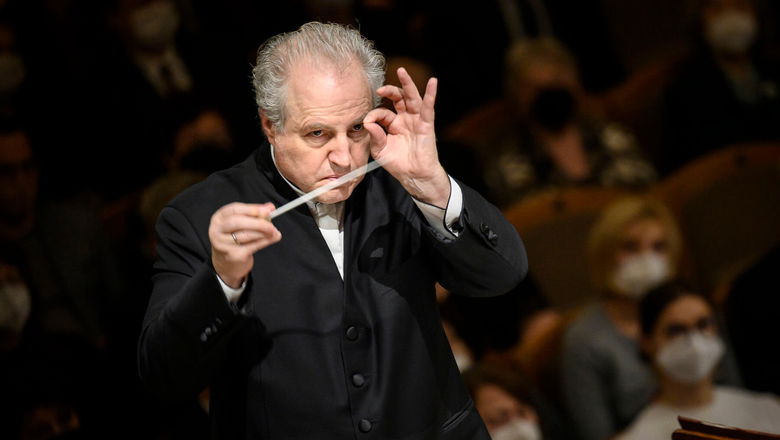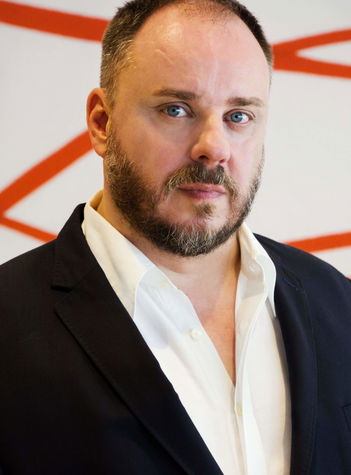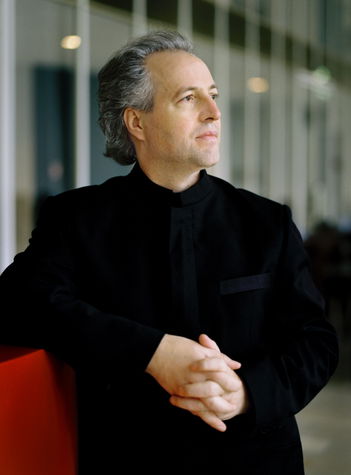1 / 6
Czech Philharmonic • Manfred Honeck
Manfred Honeck is a regular guest of the Czech Philharmonic, and he is planning a Wagner concert with the outstanding baritone Matthias Goerne. Besides an overture and arias from Richard Wagner’s operas, the concert will feature the Fourth Symphony by the composer Franz Schmidt, who experienced playing cello under the baton of Gustav Mahler.
Programme
Richard Wagner
King Mark’s monologue from Act II of the opera Tristan und Isolde (11')
Richard Wagner
"Ride of the Valkyries" from Act III of the opera Die Walküre (5')
Richard Wagner
“Wotans Abschied und Feuerzauber”, Wotan’s aria from Act III of the opera Die Walküre (15')
— Intermission —
Franz Schmidt
Symphony No. 4 (46')
Performers
Matthias Goerne baritone
Manfred Honeck conductor
Czech Philharmonic

Customer Service of Czech Philharmonic
Tel.: +420 227 059 227
E-mail: info@czechphilharmonic.cz
Customer service is available on weekdays from 9 a.m. to 6 p.m.
“With the musicians of the Czech Philharmonic, I like not only to perform familiar symphonic works, but also to join with them in revealing works to the Czech public that are still relatively new to them. His Fourth Symphony is undoubtedly a masterpiece. Its immediate, tragic inspiration was the death of Schmidt’s adult daughter. Although the symphony presents interpretive difficulties, it is exceptionally accessible to audiences. I hope you will enjoy our performance of it”, says Honeck.
Performers
Matthias Goerne baritone

Celebrated around the globe for his opera and concert performances, German baritone Matthias Goerne is a frequent guest with leading orchestras and renowned festivals and concert halls. Goerne’s artistry has been documented on numerous recordings, many of which have received rave reviews and prestigious awards, including five Grammy nominations, an ICMA award, a Gramophone Award, the BBC Music Magazine Vocal Award 2017, Diapason d’Or Arte, and the ECHO Klassik 2017 in the category “singer of the year”.
In the past two years, he has released three albums with Deutsche Grammophon: Beethoven Songs with Jan Lisiecki; a collection of Wagner, Strauss and Pfitzner Songs with Seong-Jin Cho and his new album of Schumann and Brahms Songs with Daniil Trifonov, which was just awarded “Vocal Recording of the Year” by Limelight.
He was appointed an Honorary Member of the Royal Academy of Music in London, and, in past seasons, was an Artist-in-Residence at Hamburg Elbphilharmonie and at The New York Philharmonic.
Highlights of the past season included concerts with the Amsterdam Concertgebouw Orchestra conducted by Jaap van Zweden, the Orchestre National de France under Cristian Măcelaru, the Boston Symphony under Antonio Pappano, the Munich Philharmonic under Paavo Järvi, and recitals with Christoph Eschenbach, Seong-Jin Cho, Markus Hinterhäuser, Alexandre Kantorow and Daniil Trifonov. At the Berlin State Opera Matthias Goerne performed the role of Sarastro and at the Liceu in Barcelona the title role in A. Bergʼs Wozzeck. In the summer of 2022, he sang the role of Wotan with the Los Angeles Philharmonic under Gustavo Dudamel at the Hollywood Bowl in a production by Yuval Sharon. He also appeared at the Ravinia Festival with the Chicago Symphony Orchestra and at the Salzburg Festival.
Season highlights in the 2022–2023 season include concerts with the NDR Elbphilharmonie Orchestra as well as the Orchestre National de France conducted by Andrés Orozco-Estrada, the Vienna Symphony Orchestra under Christoph Eschenbach, the Deutsche Kammerphilharmonie Bremen as well as the Pittsburgh Symphony Orchestra under Manfred Honeck, and a tour of Asia with the Dallas Symphony Orchestra under Fabio Luisi. Matthias Goerne will perform the role of Marke in Toulouse as well as the role of Amfortas at the Liceu Barcelona. Recitals with Leif Ove Andsnes, Markus Hinterhäuser and Víkingur Ólafsson will take him to Paris, London and Florence, among other cities.
Manfred Honeck conductor

Over the last quarter century, Manfred Honeck has firmly established himself as one of the world’s leading conductors, renowned for his distinctive interpretations and arrangements of a wide range of repertoire. For well over a decade, he has served as Music Director of the Pittsburgh Symphony Orchestra, celebrated in Pittsburgh and abroad. Together, they have continued a legacy of music-making that includes several Grammy nominations and a 2018 Grammy Award for Best Orchestral Performance. Manfred Honeck and the Pittsburgh Symphony Orchestra serve as cultural ambassadors for the city as one of the most frequently toured American orchestras.
Born in Austria, Manfred Honeck received his musical training at the Academy of Music in Vienna. Many years of experience as a member of the Vienna Philharmonic and the Vienna State Opera Orchestra have given his conducting a distinctive stamp. He began his career as assistant to Claudio Abbado and was subsequently engaged by the Zurich Opera House, where he was bestowed the prestigious European Conductor’s Award. Following early posts at MDR Symphony Orchestra in Leipzig and the Oslo Philharmonic Orchestra, he was appointed Music Director of the Swedish Radio Symphony Orchestra in Stockholm. For several years, he also served as Principal Guest Conductor of the Czech Philharmonic Orchestra. From 2007 to 2011, Manfred Honeck was Music Director of the Staatsoper Stuttgart. As a guest conductor Manfred Honeck has worked with the world’s leading orchestras including the Berlin Philharmonic Orchestra, Bavarian Radio Symphony Orchestra, Gewandhausorchester Leipzig, Staatskapelle Dresden, London Symphony Orchestra, Orchestre de Paris, Accademia di Santa Cecilia Rome, and the Vienna Philharmonic, and is a regular guest with all of the major American orchestras.
He also has a strong profile as opera conductor. In his four seasons as General Music Director of the Staatsoper Stuttgart, he conducted premieres of operas by Berlioz, Mozart, Poulenc, Strauss, Verdi, and Wagner. He has also appeared as a guest at leading houses such as the Semperoper Dresden, Komische Oper Berlin, Théâtre de la Monnaie in Brussels, Royal Opera of Copenhagen, and the Salzburg Festival. In autumn 2022, he will make his debut at the Metropolitan opera in New York, leading a revival of Mozart’s Idomeneo.
Manfred Honeck holds honorary doctorates from several North American universities and was awarded the honorary title of Professor by the Austrian Federal President. An international jury of critics selected him as the International Classical Music Awards “Artist of the Year” 2018.
Compositions
Richard Wagner
Programme of the fisrt half of the evening
When Richard Wagner died, newspapers all over Europe were filled with obituaries several pages long. Naturally, this was also the case in Prague, where it was repeatedly emphasised that Wagner’s rise as a composer was also connected with Bohemia, as several of his stage works were created in connection with his stays at spas in western Bohemia. Wagner won many followers in this country and especially in Prague. František Škroup was responsible for the first performances of Wagner’s music dramas in Bohemia. Tannhäuser was performed at the Estates Theatre in 1854, followed by Lohengrin in early 1856 and by Der fliegende Holländer (The Flying Dutchman) on 7 September of that year.
Wagner had known the tale of the love of Tristan and Wagner since his student days. He became familiar with it through the poem King Mark and Isolde by Julius Mosen (1803–1867), which was based on the medieval fragment of a versified romance by Gottfried von Strassburg. Gottfried’s version of the story is full of bizarre occurrences, linked sequences of episodes, and intrigues. Consumed by passion, the lovers violate the laws of society and religion, and they bring destruction upon themselves and those around them. For several years, Wagner had been living in Switzerland in exile, and he was undergoing a creative crisis. He was at work on his monumental musical setting of the myth about the Nibelungs, but he had no hopes that the work would ever be performed. He had already been thinking about Tristan und Isolde, and he mentioned the subject in 1854 in a letter to Franz Liszt. The idea came to life three years later, when Wagner was visiting the Brazilian and was told that Emperor Dom Pedro II wanted a Wagner opera performed in Rio de Janeiro, but in Italian. “I said to myself that I really ought to be able to create a passionate musical poem that would make a good impression in Italian. My thoughts turned back to Tristan and Isolde”, wrote Wagner. As he himself reported, he interrupted work on Siegfried, which was not going well, and he began writing Tristan und Isolde for Rio de Janeiro. Nothing came of the plan for an Italian opera, however, and Tristan und Isolde grew into something very different from what the composer had in mind for Brazil and even from what he was still saying he desired to write in 1860: “a lighter work, easier to produce, with modest demands for staging and a smaller scope”. Wagner completely omitted the episodes from his historical model and created a psychological study of what was going on inside the two heroes, with the “Handlung” (action), as he referred to the work, taking place in human souls. King Mark gets only one scene, but it is a long, important one that also offers magnificent insight into the depths of a human being.
Wagner worked on the tetralogy Der Ring des Nibelungen (The Ring of the Nibelung) for nearly a quarter century. The idea came to him during the revolutions of 1848–1849, when an order for his arrest was issued as a consequence of those events. He had to flee Germany, and he was not allowed to return until 1864. The mythical realm of the Nibelungs was meant to be an allegory of the social, moral, and political conflicts of the day. As was usual with Wagner, the second part of the Ring, titled Die Walküre, came into being first as a poetic text that was finished in July 1852, then he worked on the musical setting from the summer of 1854 until March 1855. While working on the tetralogy, he began to consider the building of a theatre of his own, where only his works would be played. His intention was to have the entire four-part cycle premiered in a new mecca for the arts, but this was not realised. King Ludwig II of Bavaria, who had become a Wagner enthusiast, commanded (contrary to Wagner’s wishes) that Das Rheingold be performed on 22 September 1856 at the Court Theatre in Munich, and that Die Walküre be performed on 26 June of the following year. Die Walküre was performed for the first time as part of the whole Ring cycle on 14 August 1876 at the ceremonial opening of the Festspielhaus in Bayreuth with the conductor Hans Richter. The Prelude to Act III, known as the “Ride of the Valkyries”, has become a frequently performed concert piece. In a great scene, Wotan parts with his daughter Brünnhilde, who has disobeyed him by helping mankind. He punishes her by depriving her of her divinity and declares that she shall be left to fall prey to whatever man finds her sleeping on the rock. In order to lessen her punishment, he surrounds the rock with a ring of flames made by Loge, the god of fire.
Franz Schmidt
Symphony No. 4
Franz Schmidt was born in Preßburg (Bratislava), and he received his first musical training from the organist at the cathedral of his birthplace. He reported that he was strongly influenced by his childhood experience of hearing Franz Liszt play. At age 14, Schmidt moved to Vienna, where he attended the conservatoire of the Gesellschaft der Musikfreunde and studied cello. He was self-taught as a composer apart from some theoretical training under Robert Fuchs and briefly under Anton Bruckner. In 1896 Schmidt joined the orchestra of the Court Opera, making him a member of the Vienna Philharmonic as well. He began composing relatively late, and his legacy as a composer is not large. He wrote four symphonies and two operas, and his best-known work remains the oratorio Das Buch mit sieben Siegel (The Book with Seven Seals), composed in 1935–1938.
Schmidt’s Symphony No. 1 was premiered in 1902, and it won first prize from the Musikverein, then two years later he wrote the opera Notre Dame based on Victor Hugo’s novel The Hunchback of Notre-Dame. Gustav Mahler, the music director of the Court Opera, rejected the work, so the premiere had to wait until 1 April 1914 in a production conducted by Franz Schalk. Half a year earlier, on 3 December 1913, Franz Schmidt enjoyed his first public success with the performance of his Symphony No. 2. In 1925 he became the director of Vienna’s Academy of Music and the head of the advanced course in composition, and three years later his Symphony No. 3 was premiered. In 1932, Schmidt’s daughter Emma died after having given birth. The composer was never able to come to terms with her death; he resigned from all of his positions and went into retirement. Under these circumstances, he composed his Symphony No. 4, which was premiered on 10 January 1934 in the Great Hall of Vienna’s Musikverein; Oswald Kabasta conducted the Vienna Philharmonic. “As a symphonist, Franz Schmidt is a world unto himself. He represents the classical tradition, yet he is no stagnant, fossilised conservative purveying a cobweb-infested closet of historical odds and ends”, wrote a Viennese critic after the premiere.
The symphony, which the composer called “a requiem for my daughter”, is in a single movement, and its structure is a synthesis of sonata form and a cycle of symphonic movements. The work opens with a trumpet solo with an ambiguous key centre, and the elegiac main theme is followed by a lyric second theme, which is regarded as Schmidt’s loveliest creation in his Late-Romantic style. The Adagio is a funeral march introduced by the cello, then comes a scherzo in the character of a wild tarantella that also plays the role of a sonata development section. Here, trumpet calls harken back to the beginning of the symphony, and in the middle part, the second, lyrical theme is heard. The sonata reprise (Tempo I) also serves as the final movement; the symphony ends with the lonely trumpet solo with which it began.